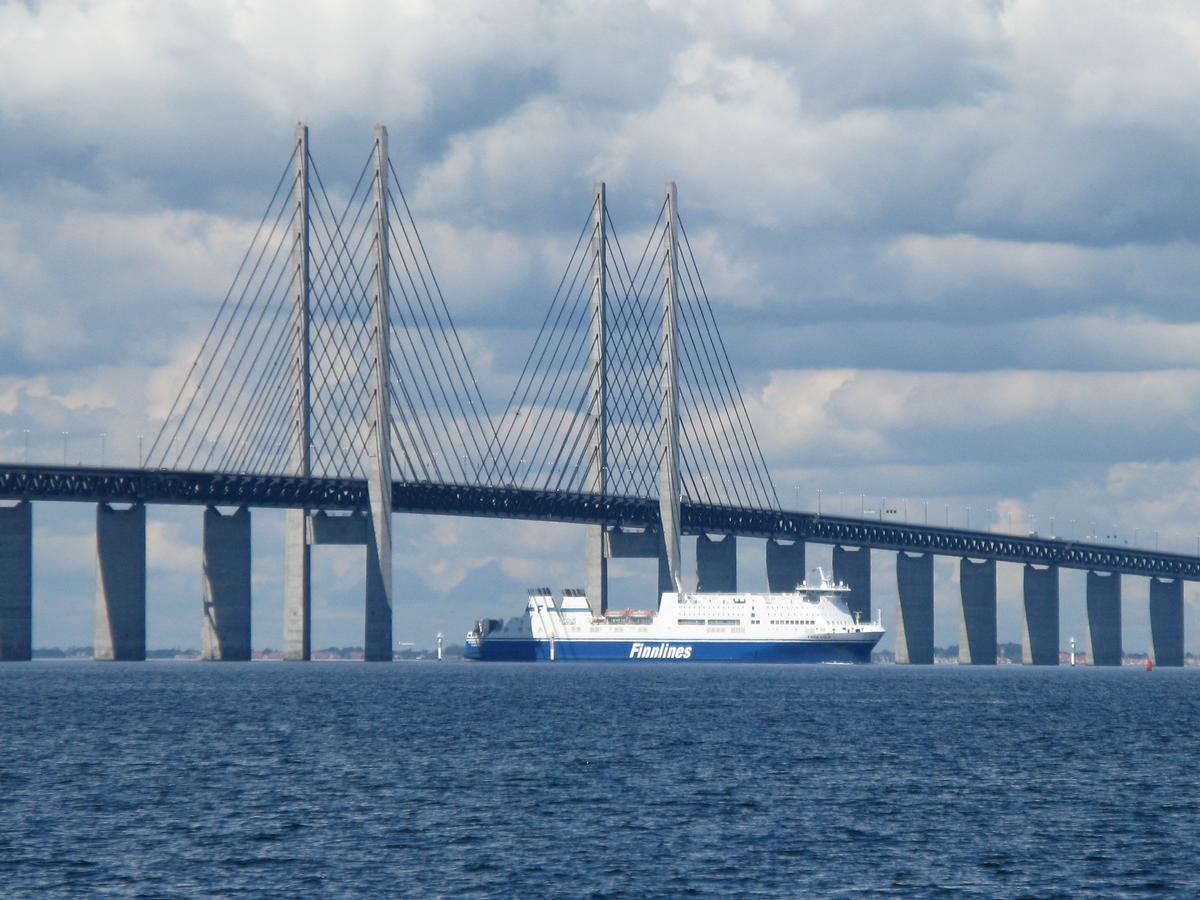The Oresund Bridge is a
“structure” that connects the city of Malmo in Sweden with the city of Copenhagen
in Denmark. I would like to refer to the Oresund Bridge as a structure because it
is not a bridge neither a tunnel, the Oresund Bridge is both.
 |
| The Oresund Bridge is tall enough so sea traffic can go through |
Sweden and Denmark were
physically connected since the beginning of time but around the late 1990s the
governments of both countries decided to change the way this countries were
connected by building this structure to connect one of most vastly expanding economic
areas in Europe. The project begun in
1991 and it was done in 2000. After nine years of work and over 15 million
euros invested in the project a group of civil engineers designed the longest and
the most efficient combined road and rail bridge in Europe.
 |
| Image of the route of the bridge |
The question is, why
did they build it like that instead of just building a normal bridge? The engineers
that were in charge of designing this project faced multiple problems. There
was air traffic due to the Copenhagen Airport and also ship traffic going
through the channel between Denmark and Sweden. They could have designed a
taller bridge so ships could go underneath it but then it would be impossible
for airplanes to land in the airport. So they designed a bridge that turns into
a tunnel deep enough so that ships can go through. This design is a very
innovative idea that revolutionized the way we see bridges today.

Unlike other
engineering projects that go bad and end up costing a lot of money to the
governments like the Central Artery/Tunnel Project in Boston, the Oresund
Bridge didn’t present any problems through the construction process and the
results are outstanding. The Oresund Bridge offers a 4-lane road carrying 6
million vehicles per year and more than 60,000 travelers per day, and two train
tracks used by another 8 million people each year.
 |
| Connection between the bridge and the tunnel |
Unlike other structures
similar to the Oresund Bridge like the Channel Tunnel that connects France and
England (that I personally travelled in), the Oresund Bridge has an outstanding
performance. Unlike the Channel Tunnel (the only possible way of transportation
is by train), in the Oresund Bridge you have the freedom to decide whether you
want to have more independency and travel in your own car rather than just
riding the train. Unlike in the Oresund Bridge, I think that traveling in the Channel
Bridge is more time consuming because it works just as an airport, you have to
get early, and do the check in procedures. I think that the designing of the
Oresund Bridge combines perfect the needs of the population because it gives
you the freedom to decide how you want to travel.
http://www.youtube.com/watch?v=g71KpjG3Bu0
Here is a link to a video that explaines everything I have talked about in this article. The problems engineers faced, and it also explains facts about the birdge like the way the strucutre was constructed and other interesintg facts.
http://www.youtube.com/watch?v=g71KpjG3Bu0
 |
| The Oresund Bridge |
The Oresund Bridge is
not just an engineering miracle but an economic push for the countries involved. Ever since the project was done, Sweden and
Denmark have experienced an economic growth because it opens more opportunities
for people to work on different countries within Europe.
I don’t see any
problems in the Oresund Bridge. If I have to rate the project I would give it a
10. 10 in design, 10 to the economic growth that generates the bridge itself
and 10 to the fact that it has an amazing performance for such an aggressive
design. This bridge has drawn a line separating past and future in the way we
look at engineering structures. I hope that one day I have a chance to work on
a similar project, where I can challenge my knowledge to break the barriers of structural
design.
I really like how you concluded this article. The ratings and talk about what the structure has brought to Denmark and Sweden really brings it to a conclusion and makes the readers really consider what it has done. I have been on/in this structure when I was studying abroad in Denmark. All travelling was done with the trains and it was a great experience. The bridge and tunnel are designed well and unless you know your going over/under a body of water, it is really not completely obvious that your not on a mainland anymore. You did well by offering examples and comparing it to other tunnels and bridges. Having a link or two to these examples would have been nice to provide additional information in case someone did not know what you were referring to. Great Job though.
ReplyDeleteHey Ursinio, this is one of the coolest structures i've ever seen. I did not know about this until you wrote on it so that is very original to me. Good job stating the importance and performance of this thing and why it is a good project.
ReplyDeleteVery interesting article! I had no idea their was such a "bridge"! You speak very highly of the bridge and I like how you compared it to the Channel Tunnel. That way you could expand upon the positives about the bridge! Great job!
ReplyDeleteThis bridge is a very interesting topic. I think your post was a good read. Once I started I did not want to stop. I agree it would be super awesome to work on something this large scale and different from everything else. Cool bridge. Good post.
ReplyDelete